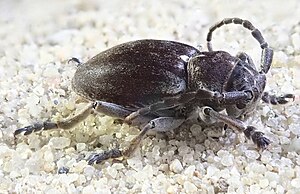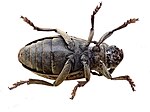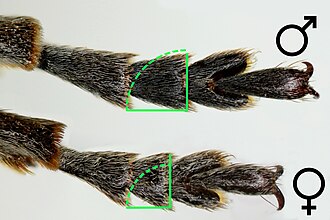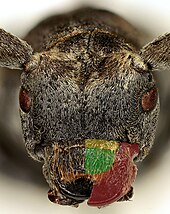Neodorcadion virleti
| Neodorcadion virleti | ||||||||||||
|---|---|---|---|---|---|---|---|---|---|---|---|---|

Male of Neodorcadion virleti |
||||||||||||
| Systematics | ||||||||||||
|
||||||||||||
| Scientific name | ||||||||||||
| Neodorcadion virleti | ||||||||||||
| ( Brullé , 1832) |
Neodorcadion virleti is a beetle from the family of the longhorn beetle and the subfamily of Weber bucks . The genus Neodorcadion is represented in Europe with eight species . The beetle is only found in parts of Greece .
Comment on the name
The Beetle was first described by Brullé in 1832 under the name Dorcadion virleti . Brullé describes the female in detail under no. 496. This is followed by a brief description of a smaller and different-looking beetle under the same number with the addition that it can be regarded as the corresponding male. Brullé also mentions that the beetle is also listed as Dorcadion graecae in museums . The material on which the description is based was collected during the Morea expedition . Brullé names the beetle after the geologist of the expedition, Pierre Théodore Virlet d'Aoust.
In 1901 Pic describes a female of the species with dark legs and antennae as Neodorcadion ionicum , and in 1914 two other forms as Neodorcadion acarnanicum and Neodorcadion subbinotatum
The genus Dorcadion was split up in 1884 by Ganglbauer into the genus Dorcadion and Neodorcadion . This explains the generic name from old Gr. νέο, 'neo' for 'new' and δορκάδιον, 'dorkadion' for lugs.
Properties of the beetle
The size of the beetle fluctuates greatly, in the male between eight and fourteen millimeters, in the more rounded and usually larger female between twelve and sixteen millimeters. The body color is black, but is covered by the thick and fine, close-fitting hair. In contrast to related species, this does not form any conspicuous white markings in either sex. On the upper side, the hairs of the male are predominantly black to reddish black, only the label is noticeably hairy white (Fig. 5 right). The female appears more or less spotty brown, the label pale yellowish (Fig. 1 below, Fig. 5 left). The hair on the underside is lighter.
The head (Fig. 6) is not sunk noticeably deep between the bases with the sensor deflections. It is irregularly dotted . The antennae are eleven links with a very short second link. The eyes are narrow kidney-shaped and encompass the antenna base on the back half. The upper lip (Fig. 7 right tinted green) is separated from the head shield by a membrane (Fig. 7 right tinted yellow). This property distinguishes the genus Neodorcadion from the genus Dorcadion . A longitudinal seam extends above this membrane over the entire head.
On both sides of the pronotum there is a sturdy, sharply pointed thorn pointing slightly backwards (Fig. 5, upper right corner). If this is not included in the calculation, the pronotum is the same width as the head. It is wider than it is long. The puncture of the pronotum becomes deeper towards the sides.
The label is elongated triangular. It is white in the male, yellowish white hair in the female.
The elytra are more dotted near the base than towards the tip, but even there only flat and not dense, the distance between the points is almost everywhere significantly larger than the diameter of the points. A dorsal rib is only formed near the base, after one eighth of the length of the wing cover it is completely extinguished. The shoulders are concise, but not protruding like teeth, but rounded. The course of the extinguished ribs can be indicated by a different color of the hair (Fig. 5, bottom right). The wing covers end individually rounded.
The spurs on the rails of the middle pair of legs are usually not as short and blunt in Neodorcadion virleti as in Neodorcadion fallax . The tarsi are equipped with a dense pad of short hair bristles on the underside. The second limb of the hind tarsi is wider than it is long in the females, and longer than it is in the males (Fig. 4).
biology
The species is found in spring on level ground on the ground that is at least partially sandy. In systematic collections of longhorn beetles in Greece using various methods, which were carried out in spring by several collectors over a period of three years, the species was only found in one year and only by one collector in fewer than three locations with fewer than 5 individuals in total. The finds were made in the Peloponnese at an altitude of 400 to 900 m.
distribution
The species occurs only in parts of Greece. It is widespread in the Peloponnese , it can also be found on the Ionian islands of Corfu and Zakinthos , as well as in the west of mainland Greece ( Epirus and Aetolia-Acarnania ).
Individual evidence
- ↑ Neodorcadion virleti at Fauna Europaea , accessed on November 16, 2019
- ↑ a b M. Brullé: Expédition scientifique de Morée Tome 3, Zoologie, 2nd Section Paris 1832 p. 258 No. 496 Dorcadion virleti in the Google book search
- ↑ Maurice Pic: Descriptions abregées de coléoptères provenant de Grèce (1) in L'échange, Revue Linéenne Vol 17, no 199, Juillet 1901 p. 52 Neodorcadion ionicum and p. 9
- ^ Maurice Pic: Matériaux pour servir à l'étude des longicornes 9th issue, 1st part, Saint-Amand (Cher), 1914 p. 8
- ↑ Ivan Löbl, Ales Smetana (Ed.): Catalog of Palaearctic Coleoptera, Vol. 6, Chrysomeloidea p. 263 Synonyms for Neodorcadion virleti in the Google book search
- ^ Ludwig Ganglbauer: Determination tables of the European Coleoptera - VIII. Cerambycidae (conclusion) in negotiations of the Imperial-Royal Zoological-Botanical Society in Vienna, 1883, XXXIII. Volume, Vienna 1884 p. 437 Neodorcadion
- ↑ Carlo Pesarini, Andrea Sabbadini: Ricerche sui Dorcadiini di Grecia. III. Le specie di Neodorcadion Ganglbauer, 1884, quelle del gruppo di Dorcadion ljubetense e descrizione della nuova specie Dorcadion ariannae (Coleoptera Cerambycidae) (Research on the Dorcadiini of Greece. III. The species of Neodorcadion and Dorcadion Ganglbauer, 1884, the the. Dorcadion ganglbauer , 1884 Description of the new species Dorcadion ariannae (Coleoptera Cerambycidae)) in Atti della Societá Italiana di Scienze Naturali e del Museo Civico di Storia Naturale in Milano. Volume 149, (I) pp . 109-124 , January 2008 pp. 7/115 key
- ↑ a b Carlo Pesarini, Andrea Sabbadini: Ricerche sui Dorcadiini di Grecia. I. Le specie del Peloponneso (Coleoptera Cerambycidae) (Research on the Dorcadiini of Greece. I. The species from the Peloponnese) in Atti della Societá Italiana di Scienze Naturali e del Museo Civico di Storia Naturale in Milan . Volume 145, (I) pp. 133-153 , June 2004 p. 135 Neodorcadion virleti
- ↑ Radosław Plewa, Krzysztof Łoś, Paweł Górski: New data of the distribution, biology and behavior of some longhorn beetles (Coleoptera, Cerambycidae) from Greece in ELATERIDARIUM Volume 5 (2011) pages 232-24 as PDF, find data no.75










